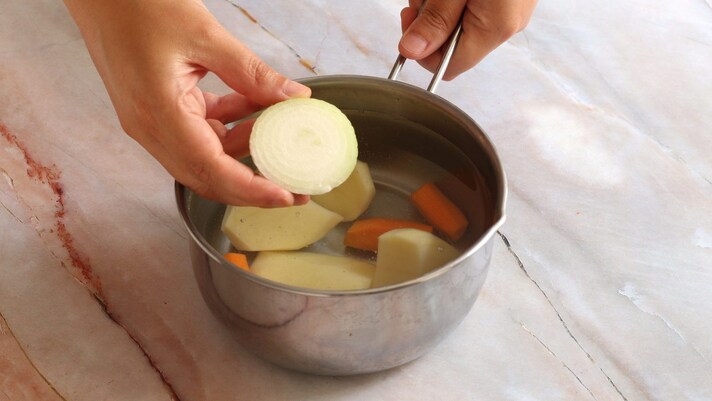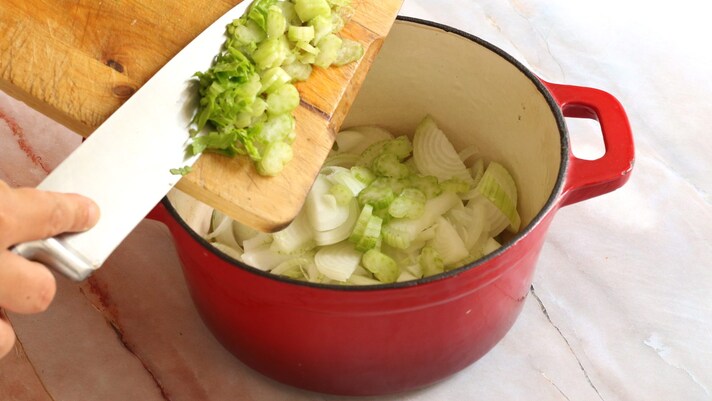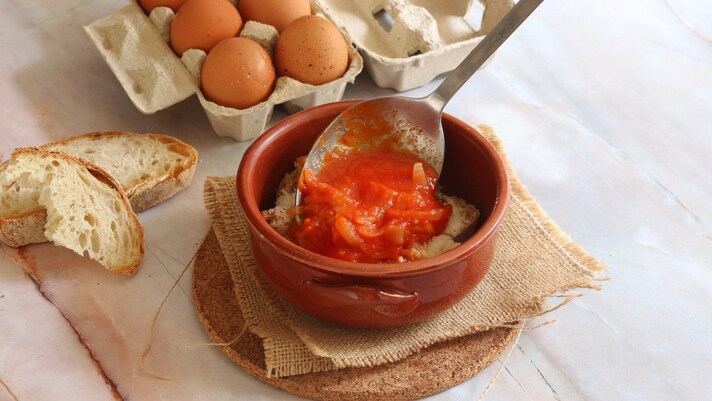
Acquacotta is an ancient recipe, typical of the poor Tuscan tradition and in particular of the Maremma. A soup with humble origins, but very tasty, born thanks to the ingenuity of farmers, shepherds and woodcutters who, to satisfy their hunger and find relief, transformed the little available into wealth. It is, therefore, a makeshift and anti-waste dish that is made up of different vegetables − depending on availability and seasonality −, but with some fixed points: tomatoes, celery, onions and aromatic herbs. Once you have obtained a thick and full-bodied soup, delicately dip the eggs, one at a time, and leave them to cook for a few minutes, just long enough for the egg white to solidify and the yolk to remain very soft.
Acquacotta is finally served inside single-portion coccotte on a base of stale Tuscan bread (also called "sciocco"), enriched with a generous sprinkling of pecorino cheese, for a rich and substantial result. Tasty and fortifying, it can be served hot during the coldest days, but is also excellent warm in summer. Depending on the season, you can use a canned tomato puree or fresh tomatoes, blanched in boiling water and peeled. If you like, you can also add a pinch of fresh or dried chili pepper, for a pleasant spicy touch.
What is Acquacotta?
Acquacotta, which translates to “cooked water” in English, is a traditional Italian soup that hails from the rustic countryside of Tuscany, particularly the Maremma region. Originally, it was a peasant dish born out of necessity, created by shepherds and farmers who relied on simple, accessible ingredients to make a hearty, nourishing meal. Acquacotta began as a basic soup made from water, stale bread, and wild herbs, then evolved over time as vegetables, onions, tomatoes, and even eggs were added to enrich its flavor and make it more filling. This humble yet flavorful soup embodies the Italian tradition of using every ingredient wisely, and it has remained a beloved comfort food, celebrated for its simplicity and rich connection to Tuscan heritage.
Pro Tips for The Best Acquacotta
- A good extra-virgin olive oil enhances the soup’s flavor, so don’t skimp here.
- Let the onions cook slowly until soft and golden to build a rich, sweet base for the soup.
- A sprig of rosemary or thyme adds depth and complements the rustic flavors.
- Authentic acquacotta calls for stale or day-old bread, which soaks up the broth beautifully without turning mushy.
- Carefully poach the eggs in the soup for a creamy texture; don’t let the water boil too hard.
- Adjust salt and pepper at the end to bring out the soup’s full flavor.
Can I Add Something Else to This Soup?
Yes, you can add other ingredients to acquacotta! Many variations include vegetables like potatoes, zucchini, or leafy greens for extra heartiness. Some even add pancetta or sausage for a richer flavor. These additions bring new layers to the traditional recipe while keeping its rustic essence.
Can I Use Ready-made Vegetable Broth Stock Instead of Making it From Scratch?
Yes, you can use readymade vegetable broth for acquacotta if you're short on time. While homemade broth adds depth and authenticity, a quality store-bought vegetable stock works well and still gives the soup a rich, comforting flavor. Just adjust the salt accordingly, as packaged broths can be salty.
Can I Use Fresh Bread for The Soup?
Yes, you can use fresh bread for acquacotta, but it’s best to use stale or day-old bread. Stale bread holds up better in the soup, soaking up the flavors without becoming too mushy. Fresh bread may dissolve quickly, altering the traditional texture.
Acquacotta Variations
Acquacotta has several regional variations. In Tuscany’s Maremma region, it’s often made simply with onions, tomatoes, and eggs. Some versions add potatoes, zucchini, or leafy greens for a heartier soup. Coastal variations might include fish or seafood, while other areas add pancetta or sausage for richness. Each variation reflects local ingredients, making acquacotta a versatile, adaptable dish.
Is This Recipe Vegan?
Traditional acquacotta can be vegan, as its base ingredients are typically vegetables, tomatoes, and bread. However, some versions include eggs or cheese for extra richness. To keep it vegan, simply skip the eggs and cheese, focusing on vegetables, herbs, and quality olive oil for flavor.
Can I Make Acquacotta Ahead of Time?
You sure can! In fact, it often tastes better as the flavors meld. Simply prepare the soup without adding the eggs, store it in the fridge for up to two days, and reheat before serving. Add freshly poached eggs just before serving for the best texture.
Can I Freeze Acquacotta?
Yes, acquacotta can be frozen, though it’s best to do so without the eggs, as they don’t freeze well. Store the cooled soup in an airtight container for up to three months. When ready to serve, thaw, reheat, and add freshly poached eggs for the best texture.
More Hearty Soups for This Fall and Winter!
Hearty Vegan Chickpea Vegetable Soup
Olive Garden Copycat Tuscan Soup
How to Store Acquacotta
The cooked water can be stored in the refrigerator, in a special airtight container, for 1-2 days. It is advisable to add the eggs only at the last moment, just before enjoying the dish.
Ingredients
How to Make Acquacotta

Clean the potato and carrot for the vegetable broth, then rinse them under running water.
Clean the potato and carrot for the vegetable broth, then rinse them under running water.

Cut the vegetables in half and collect them together with half an onion in a saucepan with the water. Add a teaspoon of salt and bring to the boil, then cook for 15 minutes.
Cut the vegetables in half and collect them together with half an onion in a saucepan with the water. Add a teaspoon of salt and bring to the boil, then cook for 15 minutes.

Peel the onions for the soup and then slice them finely.
Peel the onions for the soup and then slice them finely.

Clean the celery and slice it too.
Clean the celery and slice it too.

Pour a little oil into a large saucepan, then add the onions and let them flavor.
Pour a little oil into a large saucepan, then add the onions and let them flavor.

Add the celery too and mix well. Let it brown and wilt.
Add the celery too and mix well. Let it brown and wilt.

Cover with a couple of ladles of broth and cook gently for about 15 minutes, until the onion is very soft.
Cover with a couple of ladles of broth and cook gently for about 15 minutes, until the onion is very soft.

Then add the peeled tomatoes, bring it back to the boil and gently crush them with a wooden spoon. Let the mixture cook on low heat for about 30 minutes, allowing the soup to thicken. Use the broth to correct the density, if necessary.
Then add the peeled tomatoes, bring it back to the boil and gently crush them with a wooden spoon. Let the mixture cook on low heat for about 30 minutes, allowing the soup to thicken. Use the broth to correct the density, if necessary.

Meanwhile, cut the stale bread into regular slices.
Meanwhile, cut the stale bread into regular slices.

Break the bread into pieces and distribute it on the bottom of 4 single-serving cocottes, trying to fit them into an even layer.
Break the bread into pieces and distribute it on the bottom of 4 single-serving cocottes, trying to fit them into an even layer.

Sprinkle the surface of the bread base with a generous spoonful of grated pecorino cheese.
Sprinkle the surface of the bread base with a generous spoonful of grated pecorino cheese.

As soon as the soup appears thick, but still moist, add a few basil leaves and mix.
As soon as the soup appears thick, but still moist, add a few basil leaves and mix.

Crack one egg at a time and drop it whole into the soup. Then cook for 3-4 minutes, until the egg white appears set.
Crack one egg at a time and drop it whole into the soup. Then cook for 3-4 minutes, until the egg white appears set.

Cover each bread and cheese base with a generous layer of soup.
Cover each bread and cheese base with a generous layer of soup.

Finally, take one egg at a time and place it on top of each soup. Finish with fresh basil and a sprinkle of black pepper. Serve immediately and enjoy!
Finally, take one egg at a time and place it on top of each soup. Finish with fresh basil and a sprinkle of black pepper. Serve immediately and enjoy!
;Resize,width=767;)
